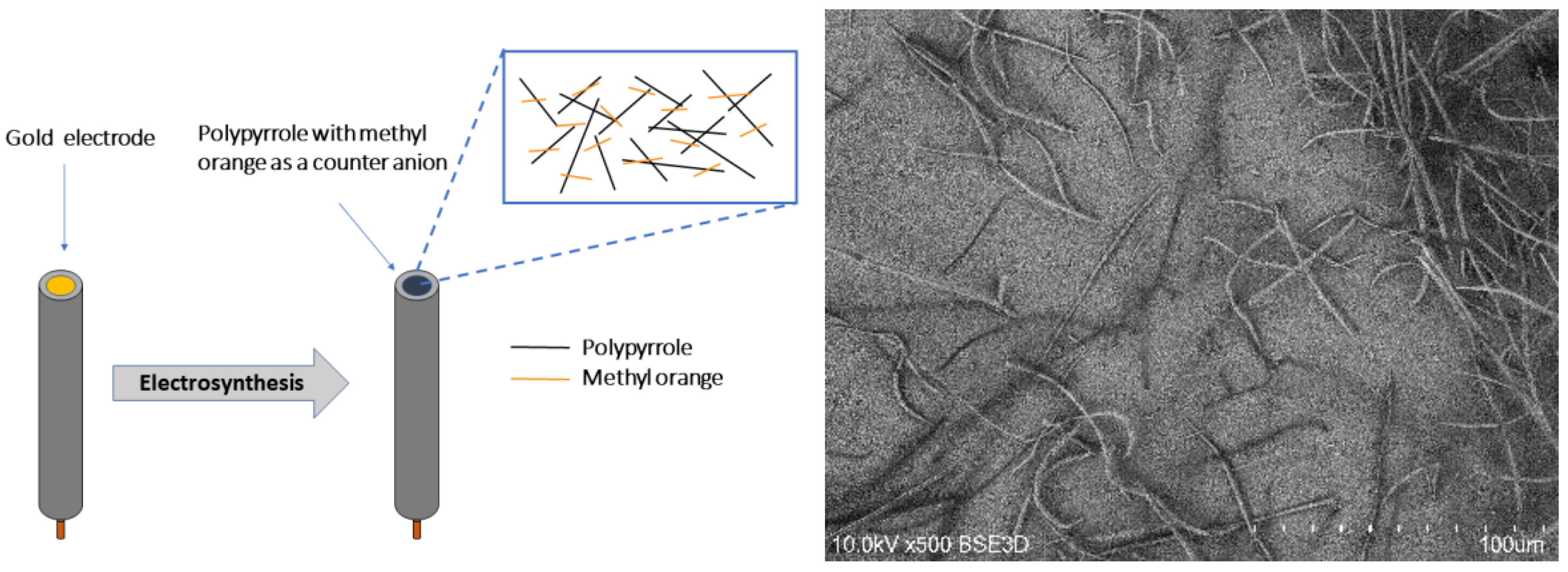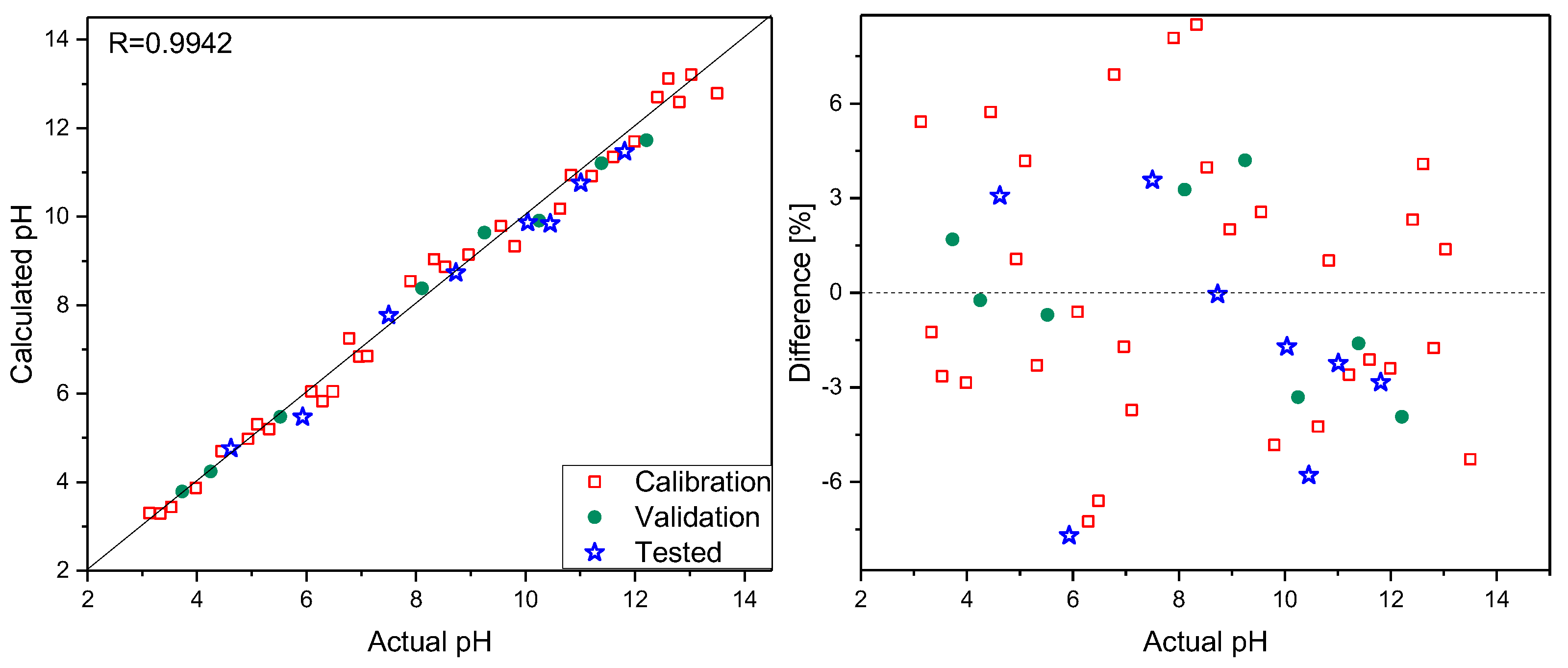Polypyrrole–Methyl Orange Raman pH Sensor
Abstract
:1. Introduction
2. Materials and Methods
2.1. Chemicals and Samples
2.2. Electrochemical Synthesis
2.3. Surface Morphology
2.4. Spectra
2.5. Chemometrics Models
3. Results
4. Conclusions
Author Contributions
Funding
Conflicts of Interest
References
- Nguyen, T.H.; Venugopala, T.; Chen, S.; Sun, T.; Grattan, K.T.V.; Taylor, S.E.; Basheer, P.A.M.; Long, A.E. Fluorescence based fibre optic pH sensor for the pH 10–13 range suitable for corrosion monitoring in concrete structures. Sens. Actuators B Chem. 2014, 191, 498–507. [Google Scholar] [CrossRef] [Green Version]
- Heider, E.C.; Myers, G.A.; Harris, J.M. Spectroscopic Microscopy Analysis of the Interior pH of Individual Phospholipid Vesicles. Anal. Chem. 2011, 83, 8230–8238. [Google Scholar] [CrossRef] [PubMed]
- Malhotra, D.; Casey, J.R. Intracellular pH Measurement. In eLS; John Wiley & Sons, Ltd: Chichester, UK, 2015; pp. 1–7. [Google Scholar]
- Ferreira, J.; Girotto, E.M. Optical pH sensitive material based on bromophenol blue-doped polypyrrole. Sens. Actuators B Chem. 2009, 137, 426–431. [Google Scholar] [CrossRef]
- Bishnoi, S.W.; Rozell, C.J.; Levin, C.S.; Gheith, M.K.; Johnson, B.R.; Johnson, D.H.; Halas, N.J. All-Optical Nanoscale pH Meter. Nano Lett. 2006, 6, 1687–1692. [Google Scholar] [CrossRef] [PubMed]
- Jamieson, L.E.; Jaworska, A.; Jiang, J.; Baranska, M.; Harrison, D.J.; Campbell, C.J. Simultaneous intracellular redox potential and pH measurements in live cells using SERS nanosensors. Analyst 2015, 140, 2330–2335. [Google Scholar] [CrossRef] [PubMed] [Green Version]
- Bisset, A.; Dines, T.J. Resonance Raman spectroscopic studies of pH indicators adsorbed on γ-Al2O3. J. Raman Spectrosc. 1995, 26, 791–798. [Google Scholar] [CrossRef]
- Gicevicius, M.; Celiesiute, R.; Kucinski, J.; Ramanaviciene, A.; Bagdziunas, G.; Ramanavicius, A. Analytical Evaluation of Optical pH-Sensitivity of Polyaniline Layer Electrochemically Deposited on ITO Electrode. J. Electrochem. Soc. 2018, 165, H903–H907. [Google Scholar] [CrossRef]
- Stejskal, J.; Trchová, M. Conducting polypyrrole nanotubes: A review. Chem. Pap. 2018, 72, 1563–1595. [Google Scholar] [CrossRef]
- Valtera, S.; Prokeš, J.; Kopecká, J.; Vrňata, M.; Trchová, M.; Varga, M.; Stejskal, J.; Kopecký, D. Dye-stimulated control of conducting polypyrrole morphology. Rsc Adv. 2017, 7, 51495–51505. [Google Scholar] [CrossRef] [Green Version]
- Efremov, E.V.; Ariese, F.; Gooijer, C. Achievements in resonance Raman spectroscopy. Anal. Chim. Acta 2008, 606, 119–134. [Google Scholar] [CrossRef] [PubMed]
- Geladi, P.; Kowalski, B.R. Partial least-squares regression: A tutorial. Anal. Chim. Acta 1986, 185, 1–17. [Google Scholar] [CrossRef]
- Kramer, R. Chemometric Techniques for Quantitative Analysis; Marcel Dekker: New York, NY, USA, 1998. [Google Scholar]
- Mazurek, S.; Szostak, R. Quantitative analysis of topical gels and ointments by FT-Raman spectroscopy. Vib. Spectrosc. 2016, 83, 1–7. [Google Scholar] [CrossRef]
- Bolton, P.; Ellis, J.; Fleming, K.; Lantzke, I. Protonation of azobenzene derivatives. I. Methyl orange and ortho-methyl orange. Aust. J. Chem. 1973, 26, 1005. [Google Scholar] [CrossRef]
- Zhang, A.; Fang, Y. Influence of adsorption orientation of methyl orange on silver colloids by Raman and fluorescence spectroscopy: pH effect. Chem. Phys. 2006, 331, 55–60. [Google Scholar] [CrossRef]
- Lee, H.; Machida, K.; Kuwae, A.; Saito, Y. Resonance raman spectra and structure of p-aminoazobenzene dyes in diprotonated form. J. Mol. Struct. 1980, 68, 51–57. [Google Scholar] [CrossRef]



| Parameter | PPy-MO Sensor | MO in Solution |
|---|---|---|
| R a | 0.9942 | 0.9903 |
| Rcv b | 0.9724 | 0.9543 |
| RSEP calibration | 3.91 | 5.11 |
| RSEP validation | 3.68 | 5.37 |
| RSEP test | 3.66 | 4.94 |
| Number of PLS factors | 5 | 5 |
© 2019 by the authors. Licensee MDPI, Basel, Switzerland. This article is an open access article distributed under the terms and conditions of the Creative Commons Attribution (CC BY) license (http://creativecommons.org/licenses/by/4.0/).
Share and Cite
Czaja, T.; Wójcik, K.; Grzeszczuk, M.; Szostak, R. Polypyrrole–Methyl Orange Raman pH Sensor. Polymers 2019, 11, 715. https://doi.org/10.3390/polym11040715
Czaja T, Wójcik K, Grzeszczuk M, Szostak R. Polypyrrole–Methyl Orange Raman pH Sensor. Polymers. 2019; 11(4):715. https://doi.org/10.3390/polym11040715
Chicago/Turabian StyleCzaja, Tomasz, Kamil Wójcik, Maria Grzeszczuk, and Roman Szostak. 2019. "Polypyrrole–Methyl Orange Raman pH Sensor" Polymers 11, no. 4: 715. https://doi.org/10.3390/polym11040715







